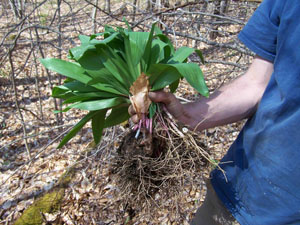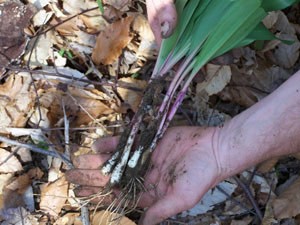While experienced foragers can make gourmet meals out of any number of wild plants – from cattail roots to stinging nettle leaves – most amateurs focus on three plants: morel mushrooms, fiddlehead ferns, and ramps (wild leeks). In foraging circles, these plants represent the holy trilogy of springtime ephemerals. The first to appear are the ramps, and where I live, they’re on right now.
In my experience, ramps are often found growing on boney hillsides, often in calcareous (limestone-rich) hardwood forests, although I’ve also found them growing in moist river-bottom soil, so go figure. The plants begin to appear as soon as the snow disappears, and achieve a harvestable size shortly thereafter. They’re characterized by broad, green leaves – shaped sort of like a deer’s ear. The leaves often have deep purple or burgundy tints on the lower stems. A dead give away is the plant’s pungent, oniony smell.
The plant resembles a scallion in both form and taste. It has a very prolific root system, so when you harvest, be careful not to separate the stem from the root bulb.
The simplest way to prepare ramps is to sauté the bulb in a little bacon fat or olive oil (add a pinch of coarse sea salt to suit your taste). The end result is a lusciously caramelized bulb that’s a perfect accompaniment to fresh, pan-seared wild brook trout. The leaves can be minced to form a garnish, or mixed into a drop-biscuit batter.
We’d love to hear from you about your foraging excursions. Are the fiddleheads out yet in your neck of the woods? The morels? Do you have any recipes you’d like to share?
Happy foraging. And Bon Appetite.



